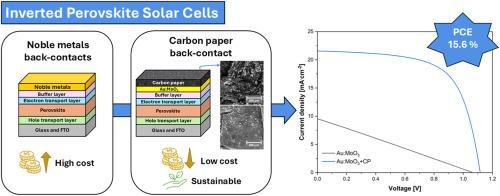倒置钙钛矿太阳能电池用高效、经济的碳纸电极
IF 11.6
2区 材料科学
Q1 CHEMISTRY, PHYSICAL
引用次数: 0
摘要
钙钛矿太阳能电池(PSCs)是最有前途的光伏技术之一,其功率转换效率(PCE)从2009年的3.8%上升到2025年的26.95%。然而,它们的商业化仍然受到诸如贵金属背触点的高成本等挑战的阻碍。因此,寻找负担得起的反向接触替代品是一个关键的研究重点。碳基材料因其丰富、低成本、化学稳定性、电子导电性、可持续性和适合大规模沉积而受到越来越多的关注。在这项工作中,有效地利用碳纸(CP)作为反向触点在倒置聚氯乙烯。为了便于电荷提取,在电子传输层和CP之间引入了一层由约7 nm的金(Au)或银(Ag)组成的薄金属中间层。对5种不同的CP进行了测试,对于含有7 nm Au + CP和7 nm Ag + CP的器件,pce分别为6.35%和8.65%。为了进一步增强电荷提取,研究了热蒸发三氧化钼掺杂金(7 nm Au:MoO3)对界面质量的影响,从而提高了界面质量,降低了复合损失。实现了PCE为15.6%的冠军装置,使碳基倒置PSCs的最高报告值之一。本文章由计算机程序翻译,如有差异,请以英文原文为准。

Highly efficient and cost-effective carbon paper electrode for inverted perovskite solar cells
Perovskite solar cells (PSCs) are among the most promising photovoltaic technologies, with their power conversion efficiency (PCE) rising from 3.8 % in 2009 to 26.95 % in 2025. However, their commercialization remains hindered by challenges such as the high cost of noble metal back-contacts. Finding affordable alternatives for back-contacts is therefore a key research focus. Carbon-based materials have attracted growing interest due to their abundance, low cost, chemical stability, electronic conductivity, sustainability, and suitability for large-scale deposition. In this work, the effective use of carbon paper (CP) as a back-contact in inverted PSCs was demonstrated. To facilitate charge extraction, a thin metal interlayer, consisting of ca. 7 nm of gold (Au) or silver (Ag), was introduced between the electron transport layer and the CP. Five different CPs were tested, yielding PCEs of 6.35 % and 8.65 % for devices incorporating 7 nm Au + CP and 7 nm Ag + CP, respectively. To further enhance charge extraction, the impact of a thermally evaporated molybdenum trioxide-doped gold (7 nm Au:MoO3) was explored, resulting in enhanced interface quality and reduced recombination losses. A champion device with a PCE of 15.6 % was achieved, making one of the highest reported values for carbon-based inverted PSCs.
求助全文
通过发布文献求助,成功后即可免费获取论文全文。
去求助
来源期刊

Carbon
工程技术-材料科学:综合
CiteScore
20.80
自引率
7.30%
发文量
0
审稿时长
23 days
期刊介绍:
The journal Carbon is an international multidisciplinary forum for communicating scientific advances in the field of carbon materials. It reports new findings related to the formation, structure, properties, behaviors, and technological applications of carbons. Carbons are a broad class of ordered or disordered solid phases composed primarily of elemental carbon, including but not limited to carbon black, carbon fibers and filaments, carbon nanotubes, diamond and diamond-like carbon, fullerenes, glassy carbon, graphite, graphene, graphene-oxide, porous carbons, pyrolytic carbon, and other sp2 and non-sp2 hybridized carbon systems. Carbon is the companion title to the open access journal Carbon Trends. Relevant application areas for carbon materials include biology and medicine, catalysis, electronic, optoelectronic, spintronic, high-frequency, and photonic devices, energy storage and conversion systems, environmental applications and water treatment, smart materials and systems, and structural and thermal applications.
 求助内容:
求助内容: 应助结果提醒方式:
应助结果提醒方式:


